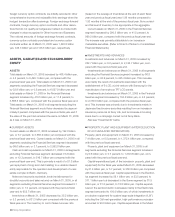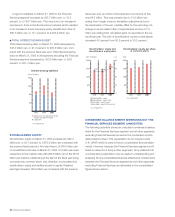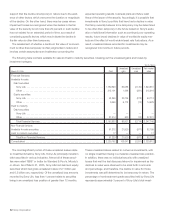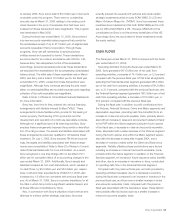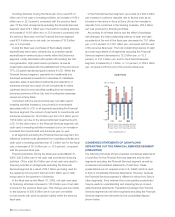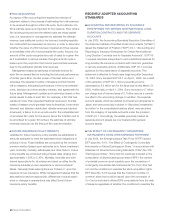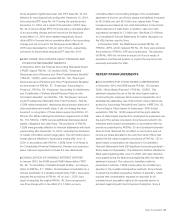Sony 2005 Annual Report Download - page 61
Download and view the complete annual report
Please find page 61 of the 2005 Sony annual report below. You can navigate through the pages in the report by either clicking on the pages listed below, or by using the keyword search tool below to find specific information within the annual report.
58 Sony Corporation
due date come within the fiscal year, and possible downward
earnings risk due to business environment change.
Sony has a policy to keep more than a certain level of cash
balance to absorb any working capital needs daily and monthly.
The cash balance on March 31, 2005, was 523.8 billion yen. A
short-term shortage in the cash balance is financed by the
issuance of CP. However, Sony controls the outstanding CP
amount through internal limits as part of its short-term debt risk
management strategy. In the fiscal year ended March 31, 2005,
there was no outstanding CP amount.
As part of its additional liquidity sources, Sony has a total of
868.7 billion yen in committed lines of credit, of which the
unused amount was approximately 863.9 billion yen as of March
31, 2005. Major committed lines of credit include 574.3 billion
yen of the Global Commitment Facilities contracted with a
syndicate of global banks, and 250 billion yen of committed lines
of credit contracted with a syndicate of Japanese banks. There
has been no major change since the last fiscal year in terms of
the total amount and composition of the committed lines of
credit. Sony uses these lines for general corporate purposes,
including the support of commercial paper programs and for
emergency purposes. There are no financial covenants in any
of Sony’s material financial agreements that would cause an
acceleration of the obligation in the event of a downgrade in
Sony’s credit ratings. However, a downgrade in Sony’s credit
ratings could increase the cost of borrowings. There are no
restrictions on how Sony’s borrowings can be used except that
some borrowings may not be used to acquire securities listed
on a U.S. exchange or traded over-the-counter in U.S., and use
of such borrowings must comply with the rules and regulations
issued by authorities such as the Board of Governors of the
Federal Reserve Board.
RATINGS
Sony considers it to be one of management’s top priorities to
maintain a stable and appropriate credit rating in order to ensure
financial flexibility for liquidity and capital management, and to
continue to maintain adequate access to sufficient funding
resources in the financial and capital markets.
In order to facilitate access to global capital markets, Sony
obtains credit ratings from two rating agencies, Moody’s
Investors Service (“Moody’s”) and Standard and Poor’s Rating
Services (“S&P”). In addition, Sony maintains a rating from
Rating and Investment Information, Inc. (“R&I”), a rating agency
in Japan, for access to the Japanese capital market.
Sony’s current debt ratings from each agency are noted below:
Moody’s S&P R&I
Long-term debt A1 (Outlook: A (Outlook: AA
Negative) Negative)
Short-term debt P-1 A-1 a-1+
On November 22, 2004, S&P downgraded Sony’s long-term
debt rating from A+ to A (outlook: negative). This action reflected
the concerns of S&P that it is uncertain if Sony will strengthen and
stabilize its profitability particularly in the electronics business,
under the severe competition and deflationary pressures. Sony’s
short-term debt rating from S&P has been unaffected. Despite the
downgrading of Sony’s long-term debt rating by S&P, Sony
believes its access to the global capital markets and ability to
issue CP for its working capital needs has not been limited.
CASH MANAGEMENT
Sony is centralizing and working to make more efficient its global
cash management activities through SGTS. The excess or
shortage of cash at most of Sony’s subsidiaries is invested or
funded by SGTS after having been netted out, although Sony
recognizes that fund transfers are limited in certain countries and
geographical areas due to restrictions on capital transactions. In
order to pursue more efficient cash management, Sony man-
ages uneven cash distribution among its subsidiaries directly or
indirectly through SGTS so that Sony can reduce unnecessary
cash and cash equivalents as well as borrowings as much as
possible.
The above description covers liquidity and capital resources
for consolidated Sony excluding the Financial Services segment
which secure liquidity on their own.
FINANCIAL SERVICES SEGMENT
In the Financial Services segment, the management of Sony
Financial Holdings Inc., Sony Life, Sony Assurance and Sony
Bank recognize the importance of securing sufficient liquidity to
cover the payment obligations that they take on as a result of
their ordinary course of business, and these companies abide
by the regulations imposed by regulatory authorities and
establish and operate under company guidelines that comply
with these regulations. Their purpose in doing so is to maintain
sufficient cash and cash equivalents and secure sufficient means
to pay their obligations. For instance, Sony Life’s cash inflows
come mainly from policyholders’ insurance premiums and Sony
Life keeps sufficient liquidity in the form of investments primarily
in various securities. Sony Bank, on the other hand, uses its
cash inflows, which come mainly from customers’ deposits
in local or foreign currencies, in order to offer housing loans
to individuals or to make bond investments, and establish
a necessary level of liquidity for the smooth settlement of
transactions.
Sony Life currently obtains ratings from four rating agencies:
A+ by S&P both for long-term local currency issuer ratings and
insurance and finance capability ratings, A+ by AM Best
Corporation for insurance and finance capability ratings, and AA
by R&I and the Japan Credit Rating Agency Ltd for insurance
claim payment capabilities ratings. Sony Bank obtained an A-/A-2
BH6/30 Adobe PageMaker 6.0J /PPC


